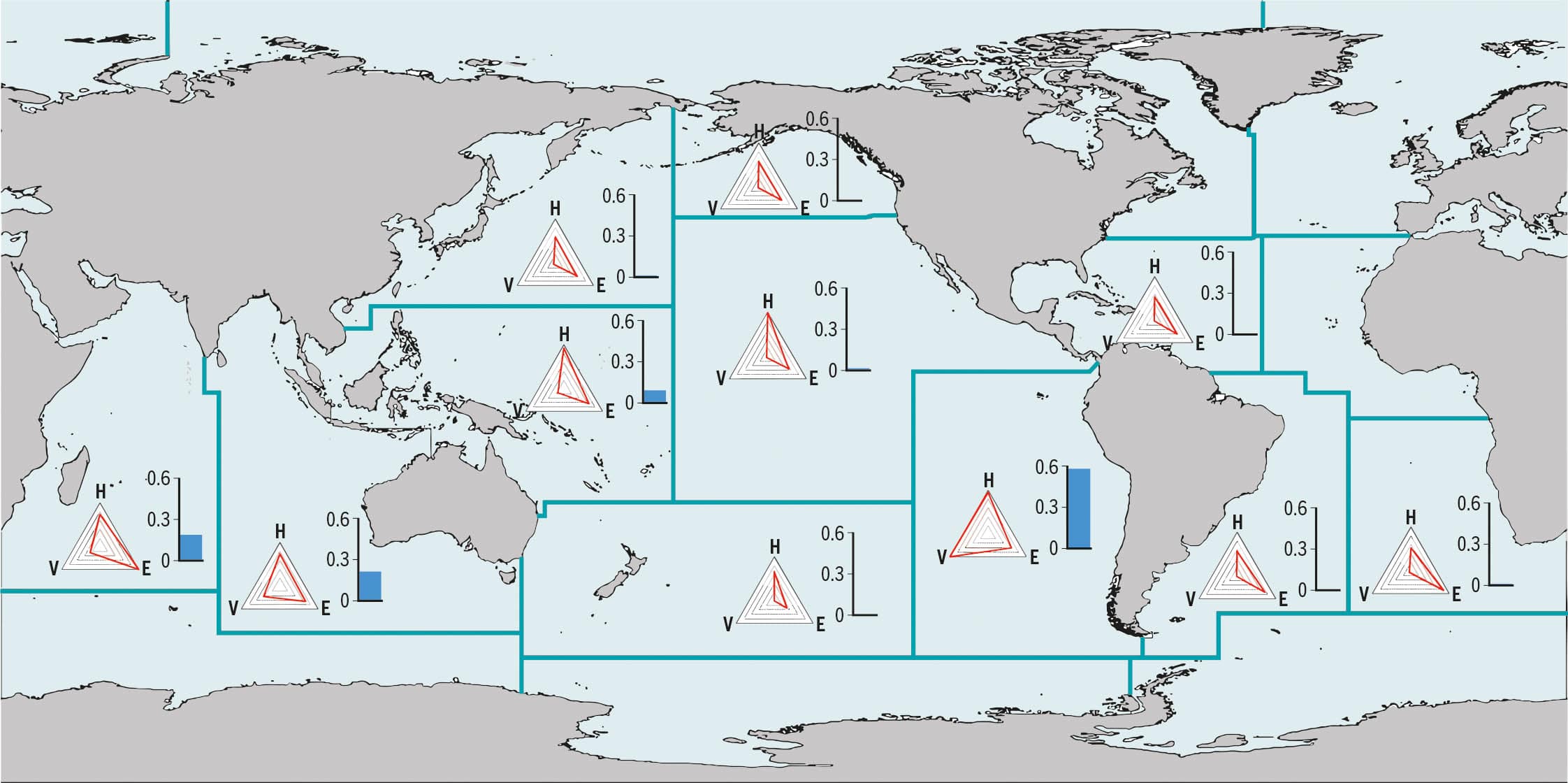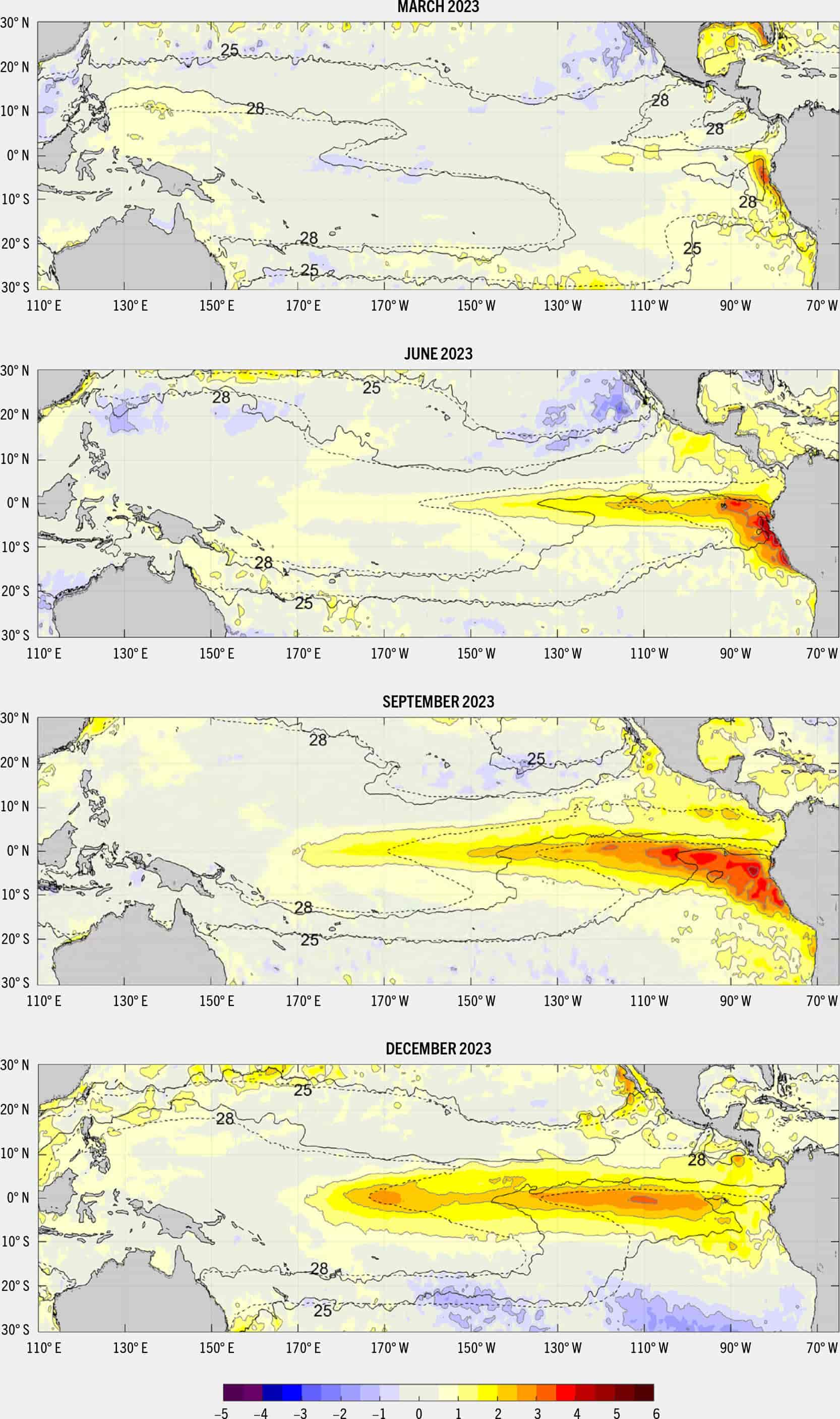Overview of El Niño and related risks in FAO Major Fishing Areas
The El Niño Southern Oscillation (ENSO) is a natural climate phenomenon that periodically causes Pacific Ocean warming (El Niño) and cooling (La Niña) and influences air surface temperature change and precipitation across the globe. During El Niño events, natural ocean conditions are considerably altered due to changes in sea surface temperature (SST) and upwelling, which affect the availability of foods and suitable habitats for fish and other marine species.
El Niño events have been linked to changes in fish catch from a variety of fisheries. Key events include those in the Tropical Pacific and Indian Ocean, in fisheries for highly migratory species like tuna, and Peruvian anchoveta in the Eastern Pacific. They also affect aquaculture infrastructure and cultured organisms; for example, increases in temperature and salinity associated with dry conditions resulting from El Niño events can strongly affect the growth and survival of Elkhorn sea moss, a popular seaweed farmed in the Philippines (see Box 21, p. 145). This industry supports around 200 000 family farms. El Niño impacts have important consequences as they affect livelihoods, food security and exports.
According to FAO’s retrospective analysis (1950 to 2023), strong to extraordinary Eastern Pacific El Niño events impacted marine fisheries in 11 of the 19 marine FAO Major Fishing Areas. The highest risk was in the Southeast Pacific, followed by the Indian Ocean and the Western and Eastern Central Pacific (Figure 62). The figure shows the analysis of El Niño-related risks for fisheries in each FAO Major Fishing Area as a function of hazard, exposure and vulnerability levels.
FIGURE 62El Niño risk analysis in fao Major Fishing Areas

SOURCES: Risk analysis based on NOAA PSL. 2024. NOAA OI SST V2 High Resolution Dataset [Accessed on 12 November 2023]. https://psl.noaa.gov Marine fisheries global capture data from FAO. 2023. FishStatJ. [Accessed on 12 November 2021]. https://www.fao.org/fishery/en/statistics/software/fishstatj. Licence: CC-BY-4.0.
FAO. 2024. FAO Major Fishing Areas for Statistical Purposes. In: Fisheries and Aquaculture. [Cited 12 November 2021]. https://www.fao.org/fishery/en/area/search
El Niño 2023–2024 – changes in ocean conditions
La Niña conditions prevailed in the Tropical Pacific Ocean from September 2021 to January 2023. In February 2023, the SST increased in the far Equatorial Eastern Pacific, suggesting the initiation of an El Niño event. By early March 2023, waters had warmed, especially in the Peruvian nearshore waters. From March to July 2023, the anomalous warming in the Equatorial Southeast Pacific continued to increase.
Subsequently, the warm SST anomalies spread westwards, expanding El Niño conditions into the Central Equatorial Pacific in May 2023. The increase in SST anomalies peaked in the Equatorial Southeast Pacific in August 2023 and then gradually decreased; in contrast, in the Central and Western Equatorial Pacific, anomalies were still increasing during the spring of 2023. Between November and December 2023, El Niño attained a strong to very strong intensity in SST in the Central Equatorial Pacific. Nevertheless, SST anomalies were still higher in the Eastern Pacific than in the Western Pacific, through to February 2024. Figure 63 summarizes the spatial and temporal features of El Niño 2023–2024.
FIGURE 63Average monthly sea surface temperature anomalies during the evolution of the 2023–2024 El Niño

El Niño intensity declined during the first quarter of 2024, ending in the spring. However, the impacts on the fisheries and aquaculture sector will likely remain for a longer period, as some fishery stocks and key fish habitats such as coral reefs might take years to recover.
El Niño 2023–2024 – impacts on fishery resources
The impacts of El Niño differ across different geographical areas, target species, types of fishing or aquaculture, and can have both negative and positive impacts. For example, in 2023, El Niño conditions diminished the habitat of cold coastal water species like Peruvian anchoveta. The anchoveta fishery is the world’s largest monospecific fishery, yielding on average 4.4 million tonnes annually and 75 percent of total Peruvian landings in the past five years. During strong Eastern Pacific El Niño events such as in 2023–2024, anchoveta experiences reduced habitat and food availability, with impacts on distribution, reproduction and recruitment, resulting in biomass reductions that can extend beyond the event’s end. For Peru, negative effects included a reduction of 50 percent in industrial landings in 2023 compared to 2022, although a recovery is expected during 2024. As the fishery is used to produce fishmeal and fish oil used for fed aquaculture, catch losses not only impact local livelihoods, employment and national export revenues, but also impair aquaculture production globally.
Due to El Niño, the warm pool usually located in the Western Pacific started moving eastwards into the Central Pacific in the 2023 summer. During the El Niño demise in the first quarter of 2024, the warm pool was still more eastward than during non-El Niño years. On the other hand, marine heatwaves increased in the Western and Central Pacific during the mature phase of the event. As a result, coral reef communities at islands located in this area were exposed to extended periods of thermal stress that increased mortality risks for corals and associated coastal fishing resources.
El Niño also impacts tuna fisheries in Pacific Island Countries and Territories (PICTs) where tuna fishing is a significant contributor to the GDP. El Niño-driven changes in habitat conditions favour an eastward shift in the distribution of skipjack tuna but tend to increase the catchability and recruitment of yellowfin tuna in the Western Pacific. As a result, to the end of 2023, El Niño had a positive impact on skipjack fishing in the easternmost PICTs’ exclusive economic zones (EEZs). Increased availability for purse seiners of yellowfin tuna was observed in 2023, arguably due to the shoaling of the mixed layer in the most western EEZs, thus improving livelihoods and income in some areas of the Pacific while reducing them in others.
These findings emphasize the need to implement adaptive fisheries management measures, particularly since climate models project more frequent extreme ENSO events due to global warming. Practices such as dynamic adjustment of the fishing season and limiting effort and access to fishing grounds based on near real-time monitoring will help managers, fishers and coastal communities cope with ENSO-related impacts, and will enhance their adaptive capacity, improving early warning systems, strengthening risk assessments and raising awareness on ENSO. In addition, disaster preparedness and response at the local and national level – while promoting the diversification of livelihoods – are of crucial importance.

